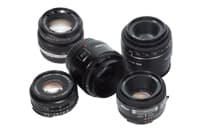New Sony Alpha DSLR lenses previewed
Preview of Sony 85mm f/2.8 SAM (SAL85F28) and the Carl Zeiss Distagon T* 24mm f/2 ZA SSM (SAL24F20Z) lenses

We?ve had pre-production samples of two of the three lenses Sony has announced today, to get a feel for over the last few weeks. Both are designed for Sony?s Alpha full frame cameras, of which there are only two. The Carl Zeiss 24mm is standard high-quality fare, and presents few surprises beyond the constant surprise of its weight every time it is picked up. The 85mm f/2.8 however appears to be the first of a new breed of lower-end full frame optics, designed to be ?good value?. The concept seems somewhat at odds with the idea of full frame DSLRs and the costs associated with buying one, so perhaps Sony is trying to tell us that a lower cost full frame model is on its way. While both lenses can be used on Alpha APS-C bodies, there seems little point ? the 24mm becomes an unspectacular 36mm f/2 while the portrait 85mm becomes a street-shooting 127mm f/2.8. Clearly they really are intended for full frame bodies, and with two such different lenses we could perhaps feel justified in expecting two types of full frame camera to go with them.
While optically the 24mm CZ lens is more interesting I will start with the 85mm f/2.8 because it is so surprising.
 Sony 85mm f/2.8 SAM (SAL85F28)
Sony 85mm f/2.8 SAM (SAL85F28)

Sony 85mm f/2.8 SAM (SAL85F28)
This really does not look or feel like a full frame lens. It weighs 175g and has a plastic barrel and a plastic mount. I had to try it on the A900 just to make sure it wasn’t designed just for APS-C. When on the camera it makes so little difference to the over all weight that you might need to constantly check you have a lens attached at all. Built to a Sonnar-style design it features just six elements in five groups, and uses Sony?s SAM (Smooth Autofocus Motor) to drive the AF.

To be honest I didn?t expect it to be much good. It feels like a cheap kit lens, and a maximum aperture of f/2.8 ? slow for this focal length ? suggests some stopping-down to mask optical problems. The 85mm portrait lens is still very much in fashion, but most feature an aperture wider than f/2 ? f/1.2 being the ultimate and f/1.8 the norm. F/2.8 seems somewhat staid in comparison.
In use it actually performs very well. The unit I was using was not completely finished, but it didn?t show. The AF is quick and the pictures are sharp. Although f/2.8 doesn?t allow the low-light working that wider apertures do, it is still respectable, and in fact most ultra-wide aperture 85mm lenses do not perform at their best wide open. In practical terms too, for a headshot f/1.4 presents depth of field a little too shallow – except for showing off shallow depth of field.
Working wide-open and at a distance of just a few feet, I found depth of field just about shallow enough without feeling I wanted to open the aperture any more. A diffused desk lamp allowed a hand-hold-able shutter speed of 1/50sec at ISO 1600 ? so I didn?t feel deprived at all.
The resulting images are sharp and crisp, with attractive out of focus areas. In all, I am very pleased with the results.
Sony has yet to announce a price for this lens, but a spokesperson has indicated to me that we should expect it to cost in the region of £175. To be frank, in the hand the lens feels like a £175 lens, but the results demonstrate that it really will be excellent value for money. The existing 85mm option for Sony users is the Carl Zeiss T* 85mm f/1.4 ZA (SAL85F14Z), which will set you back a more full-frame-price of £1200.
The new lens is due to go on sale in September.
 Carl Zeiss Distagon T* 24mm f/2 ZA SSM (SAL24F20Z)
Carl Zeiss Distagon T* 24mm f/2 ZA SSM (SAL24F20Z)

Carl Zeiss Distagon T* 24mm f/2 ZA SSM (SAL24F20Z)
This lens is much more in-line with what I?d expect from a Sony ZA full frame lens ? big, bulky, beautifully made and expensive. There is no chance you will not know whether this lens is attached to your camera, as it weighs a significant 555g. When fitted to the A900 the pair are ‘substantial’ rather than ‘excessive’, and as neither is exactly lightweight they balance very nicely. Through the viewfinder the lens is bright and clear enough to make manual focusing easy even when the widest aperture of f/2 is used for close subjects. AF operation is fast and quiet, contrasting markedly with the attention-grabbing clatter of the A900?s mirror and shutter action. The lens allows manual focus over-ride at any time, just by turning the wide-band focusing ring ? the action is smooth and very satisfying.
Although trying not to look too hard at these results from a pre-production lens, there is little to criticise. Wide-open resolution appears excellent, and there are few signs of any problems. There are two ED glasses and two aspherical elements within the total of nine elements in seven groups, and they appear to be doing what they should be.

The lens is very nice to use, and if you already have ZA lenses for your Alpha this unit will fit in perfectly ? it?s solid, feels like quality and produces excellent results.
This model is due to arrive here (the UK) in September and will cost around £1100 ? much more in line with what we might expect.
 Specifications
Specifications










